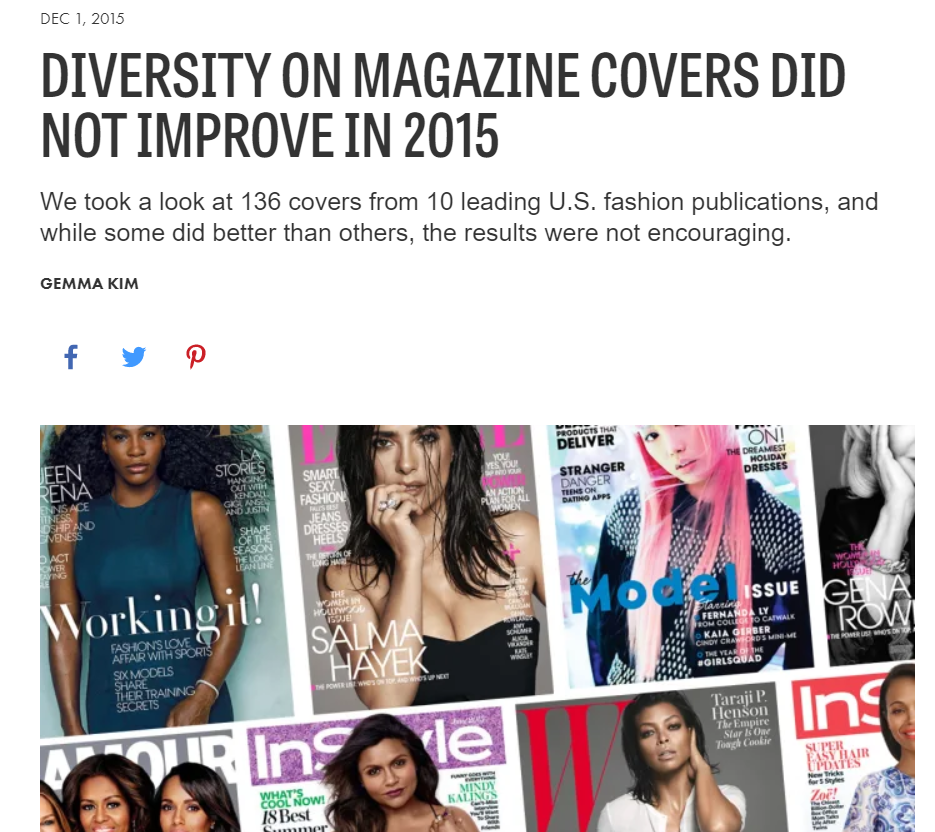13 Race and Ethnicity
Module Learning Objectives (MLO)
In this chapter, you will
- MLO 13.1 Identify foundational concepts related to race, ethnicity, fashion, identity, appearance, and dress. [CLO 1]
- MLO 13.2 Identify different types of dress worn by people of color in the United States. [CLO 1]
- MLO 13.3 Identify people of color’s experiences wearing different dress object reflecting their race and/or ethnicity in the United States. [CLO 2]
- MLO 13.4 Identify different fashion brands that produce and sell dress objects for people of color in the United States. [CLO 2]
- MLO 13.5 Explain the role of dress and appearance in the development of one’s racial and/or ethnic identity in the United States. [CLO 2]
- MLO 13.6 Examine how dress and appearance of people of color in the United States are represented in the fashion system (e.g., advertisements or retailers). [CLO 3]
- MLO 13.7 Examine social justice issues related to dress and appearance for people of color in the United States. [CLO 3]
- MLO 13.8 Deconstruct your own perspectives and approach to understanding the dress and appearance of people of color in the United States. [CLO 4]
- MLO 13.9 Identify the driving forces of transformative social justice change in the fashion system related to people of color in the United States. [CLO 5]
Ethnicity versus Race
Race refers to physical characteristics that separate individuals into groups. In contrast, ethnicity is culturally determined and may not be reflected physically. Both, however, are social constructions reinforced by society to classify human differences. These classifications are often based on skin color, hair texture, and facial features, as well as other arbitrary physical characteristics. The categories that have evolved to categorize groups are different depending on one’s location and culture, and the meanings of these terms have shifted over time.
“One-Drop Rule”
In the United States, racial formation developed along an opposition between Black and White. Anyone with “one drop” of Blackness was identified as Black. So, if someone has a White mother and Black father, they will typically identify as Black (e.g., Barack Obama). This classification has roots in the system of slavery in the United States.
Racial classification: South Africa during Apartheid
Racial segregation was legal In South Africa from 1948 to 1994. An individual was considered Black if a pencil could stick in their hair and not fall out. If it fell, the individual was “white.” This is clearly a flawed system, but it was not meant to be exact or accurate; it was only meant to reinforce the existing perceptions and classifications of race within that culture.
What’s in a Name?
There are various names for different ethnic groups in the United States; these have differed over time and with a growing understanding of the various cultures represented in US society. It is important to develop a sensitivity to the terms marginalized groups prefer for themselves.
African American vs. Black
African Americans or Black people prefer different terms for various reasons, from generational differences to political or social differences. Not all African Americans identify as Black, and not all Black people identify as African American. This is particularly true of Black people who live in America but were born in, for example, England, Kenya, or Mexico.
Native American vs. Indian
Similarly, different Native American groups use different names to refer to themselves; some use Indigenous peoples or First Nations. Although the term Indian has often received pushback, since the people did not originate in India, some Native Americans do use the term American Indian to refer to themselves.
Hispanic American vs. Latino
Hispanic and Latino/a/x do not necessarily refer to the same thing. Hispanic refers to individuals with heritage in a Spanish-speaking country, whereas Latino/a/x refers to someone from Latin America. While there is some overlap in these definitions, they are not interchangeable! It is often more accurate to refer to someone by their nation of origin rather than a broad category. For example, Mexican, Chilean, Puerto Rican, and other more specific classifications might be used to distinguish an individual rather than the term Latino.
Oriental vs. Asian American
Finally, some terms used to refer to a group of people are still used despite being derogatory. Oriental is one such term that is no longer in accepted use. Instead of calling someone “an Oriental,” you could refer to them as Asian American. However, similar to Latino/a/x individuals, it’s often best to refer to Asian people living in the United States based on their preferred term, which might be their ethnicity of origin (Korean, Taiwanese, Chinese, Hawaiian, for example), or a more specific Americanized term (e.g., Chinese American).
Roots of Ethnicity
Ethnicity is a learned cultural heritage typified by national origin, ideology, style of dress, dietary habits, and, often, language. While a foreign-exchange student from China and a Chinese person whose family has lived in the United States for three generations might share a race, they will have differences in ethnicity based on the different ways Chinese American culture has evolved to have its own style of dress, dietary habits, and ideology.
Watch this short film about Chinese culture, appearance, and fashion.
Inequalities of Power
Historically, people of color (POC), ethnic minorities, have faced racism and exclusion from mainstream US society. Those in power in the United States are White people with European heritage. Achieving economic and social equality with White individuals has been difficult for people of color. This power difference is referred to as hegemony.
Racial equity is when equal regard is offered to all races. It is the elimination of policies, practices, attitudes, and cultural messages that reinforce differential outcomes by race or that fail to eliminate them.
This inequality is reflected in unequal representation within fashion magazines. Research has shown that fashion magazines lack racial diversity, despite improvement over time. Jackson & Ervin (1991) studied racial representation in Cosmopolitan, Glamour, and Vogue between 1986 and 1988. 97% of the models represented were White. POC representation consisted of 2.4% Black individuals, 0.5% Asian individuals, and virtually no Hispanic individuals . Building on this work, Mayo et al. (2005). studied racial representation in Vogue between 1993 and 1997. They found a slight increase in Black representation (6.9%), though the vast majority of models were still White. Finally, Fowler & Carlson (2015) studied 2011 issues of Elle, Cosmopolitan, Harper’s Bazaar, Vogue, and Marie Claire and found that the representation were 83% white, 1.9& Asian, 5.2% Hispanic, and only 3.7% Black.
Fashion media, also highlights unequal representation; see, for example, this article by Gemma Kim, published on Fashionista.com:

What is Colorism?
Colorism is “interracial discrimination based on skin color stratification. Typically, lighter skin is preferred, along with facial and physical featuresmore closely associated with Caucasian standards of beauty” (Hunter, 2005). Since slavery, there has been evidence of discrimination based on skin color. Lighter-skinned Black slaves were more likely to be given indoor work, while darker-skinned Black slaves were more likely to be given field work. This is typified in the “paper-bag test,” which was used to compare a person’s complexion to a paper bag in order to exclude darker-skinned African Americans from clubs, schools, and churches (Russell, Wilson, & Hall, 1992)
Colorism in Hollywood
Lupita Nyong’o, a Hollywood actor and fashion icon, spoke out in 2014 about her experience with colorism in the fashion industry. Watch Nyong’o’s “Black Women in Hollywood” speech, posted by Essence.com (Essence, 2020). This quote from the clip highlights why diversity must be represented:
“And then Alek Wek came on the international scene. A celebrated model, she was dark as night, she was on all of the runways and in every magazine and everyone was talking about how beautiful she was. . . . When I saw Alek I inadvertently saw a reflection of myself that I could not deny.” (Lupita Nyong’o, 2014)
To access a full transcript of Lupita’s speech, download this document: Lupita Nyongo Speech Video Transcript [DOC]
This isn’t just anecdotally common, either: studies have looked into colorism in the fashion industry just as they have racial representation. Even within Ebony magazine, which focuses on and features Black people in the United States, light-skinned models and those with more European facial features dominated the magazine from the 1950s to the 1990s (Leslie, 1995; Keenan, 1996).
Example: Hair Straightening
African Americans have used hair straightening as one strategy to fit into the dominant White society after slavery was abolished (Byrd & Tharps, 2001). Hierarchies that privilege straight hair and finer hair textures still exist today. Robinson (2011) studied what Black women perceived as “good hair” and “bad hair” based on the society in which they live, and the women in the study stated that “good hair does not need straightening” (Robinson, 2011, 368).
Watch this short film about Black women, hair, and style.
The fashion industry reinforces the effects of colorism by offering skin-bleaching creams and hair-straightening techniques (Averhart & Bigler, 1997; Brooks, Brown, & Hampton, 2008; Porter, 1991; Young- Hyman, Schlundt, Herman-Wenderoth, & Bozylinski, 2003).
Colorism in Korean Fashion Media
The use of imagery that reinforces colorism by the fashion industry has become particularly pervasive in South and East Asian culture, particularly among media aimed at young Korean women. At Iowa State University, graduate student Eunji Choi, in their MS thesis, “Korean fashion media, beauty ideals, and colorism: Examining the prominence of Whiteness between 2013 and 2017 in Céci magazine,” analyzed images presented withine Céci (2018). They chose this magazine since it is produced in and for Korea and widely circulated. Choi coded the images within the magazine based on race (Black, Asian, White, Other Person of Color, or Indistinguishable), facial features (White-appearing, Black-appearing, Asian-appearing), and hairstyle (straight, curly, tied, no hair). They found that the most common race represented was Asian, followed by White, and that most of the Asian women presented in the magazine had White-leaning facial features and unnaturally dyed and styled hair to reflect the hairstyles popular among White women (curly, lighter hair).
Watch this short film about Korean culture, women, identity, and dress.
Watch this short film about Indian culture, women, dress, and identity.
Watch this short film about Comanche identity, fashion, and dress.

Race and Ethnicity Case Study
Step One: Become familiar with the case study.
- The case study attached below is a Word document and can be downloaded. It includes the task, evaluation, and template for the case study:
Race and Ethnicity Case Study [DOC]
Step Two: Submit your complete assignment on Canvas.
- Format your document.
- Remember to check the submission against the rubric.

